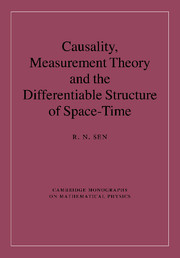Book contents
- Frontmatter
- Contents
- Preface
- Acknowledgements
- To the reader
- Prologue
- Part I Causality and differentiable structure
- Introduction to Part I
- 1 Mathematical structures on sets of points
- 2 Definition of causality on a structureless set
- 3 The topology of ordered spaces
- 4 Completion of ordered spaces
- 5 Structures on order-complete spaces
- Part II Geometrical points and measurement theory
- Mathematical appendices
- List of Symbols for Part I
- References
- Index
4 - Completion of ordered spaces
Published online by Cambridge University Press: 04 August 2010
- Frontmatter
- Contents
- Preface
- Acknowledgements
- To the reader
- Prologue
- Part I Causality and differentiable structure
- Introduction to Part I
- 1 Mathematical structures on sets of points
- 2 Definition of causality on a structureless set
- 3 The topology of ordered spaces
- 4 Completion of ordered spaces
- 5 Structures on order-complete spaces
- Part II Geometrical points and measurement theory
- Mathematical appendices
- List of Symbols for Part I
- References
- Index
Summary
The ordered spaces M that we have defined are not complete, i.e, they are not necessarily complete. Strictly speaking, we cannot yet speak of the completeness of ordered spaces. The only mathematical structure defined so far on an ordered space is the topological structure, and completeness is not a topological notion.
Let us therefore start by considering light rays, which, by definition, are totally ordered sets possessing the property that between any two points lies a third. This property is shared by the set of rational numbers in their natural order. The Dedekind completion (page 253) of such sets invokes only the order property, and results in a set that has the least upper bound property (page 255). Such sets are locally homeomorphic with ℝ. One may therefore talk about light rays that are complete, meaning thereby that they are Dedekind-complete.
In the strictly technical sense of the term, no proofs are given in this chapter, with a few exceptions in Section 4.7. However, results that require complicated proofs are broken down into smaller lemmas and propositions, and bare statements are often accompanied by an explanation of what the result is driving at. The reader who is not mathematically inclined may not be able to reconstruct the proofs independently, but should be able to follow how the argument develops. Sometimes, if the result seems obvious but the proof is not, the warning ‘requires proof’ is added in parenthesis.
- Type
- Chapter
- Information
- Publisher: Cambridge University PressPrint publication year: 2010

